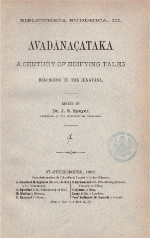|
|
| |

|

|
[Bibliotheca Buddhica III:] Avadānaçataka. A Century of Edifying Tales belonging to the Hīnayāna. Vol. 1. Edited by J.S. Speyer. St.-Pétersbourg, 1902 (I), 1903 (II), 1904 (III), 1906 (IV).
Introduction
The Avadānaçataka is a collection of sacred tales, made up of just one hundred avadānas divided into ten sections (vargas) of ten tales each; avadāna nr. 5 is lost in the Sanskrit original, see below. Its qualification as a Hīnayāna-sūtra is based on Chinese authority (see Bunyiu Nanjio’s Catalogue, nr. 1324) and fully complies with the general character and the style of the work. It was translated into Chinese at as early a date as the third century A. D.; this translation is still extant and has its place in the Chinese Tripiṭaka. The original may have been composed one or two centuries before, as I tried to prove from several indications in a paper read at the Amsterdam Royal Academy; see Verslagen en Mededeelingen van de Koninklijke Akademie van Wetenschappen, Vierde Reeks, III, 361—418. In the colophon at the end of the work it is named a Sugatabhāṣita, and in a çloka added in one of the modern manuscripts (D), subuddhavākya.
The Tibetan translation of our text is vol. XXIX of Mdo. It has been compared with the Sanskrit original by Burnouf and the late M. Feer. The former states it to be very literal (Introduction, original edit. p. 7), the latter has got much help from it for his French translation of the Avadānaçataka, which appeared in 1891 in the XYIIId volume of the Annales du Musée Guimet. It is the place here to give utterance to my feelings of gratitude towards M. Feer, who put at my disposal his thorough knowledge of the Tibetan language and provided me with every in-formation concerning the Tibetan version that I wanted [1: A few days after these words were written, I learnt the death of my friend Feer. His decease is a lamentable loss to Tibetan and Buddhistic studies.]). It is to him that I am indebted for all quotations from the Tibetan, put in the foot-notes of this edition, many of them important for the explanation or constitution of the text. The Chinese translation did not prove as useful an instrument. Being made rather freely, it has many abridgments and omissions; now and then it contains more than our Sanskrit redaction. My friend Prof. de Groot at Leiden, at my request, had the kindness to compare the Chinese translation, and it is to him that I owe the information thereabout given in the foot-notes... PDF-files PDF-files
The entire volume
Keywords
|
|
|
|
Random news: Announcements |
|
On October 16, 2023, the Serindica Laboratory Seminar will take place at the IOM RAS. The program of the conference is now available. |
|
Read more...
|
|
|
|
|

